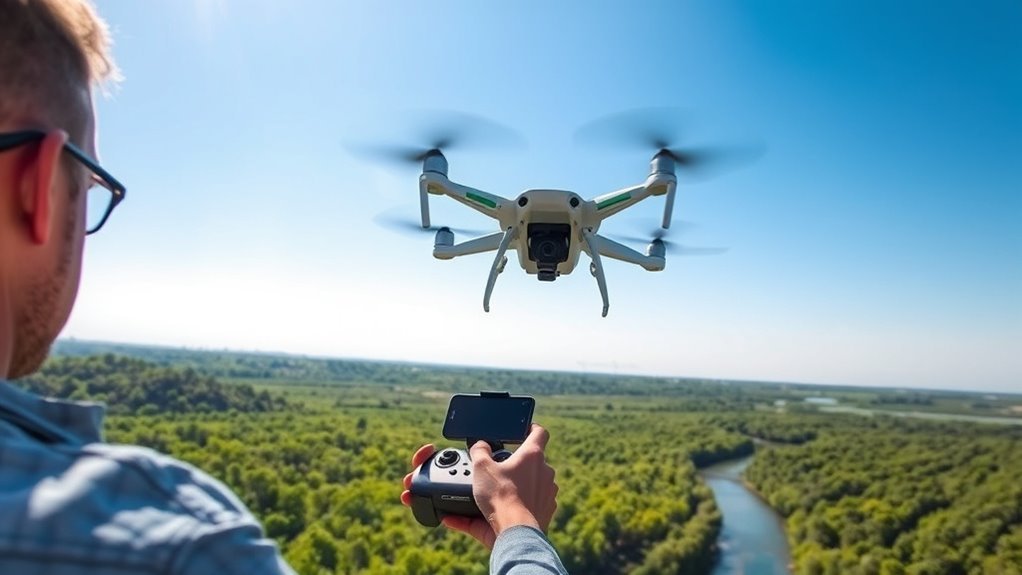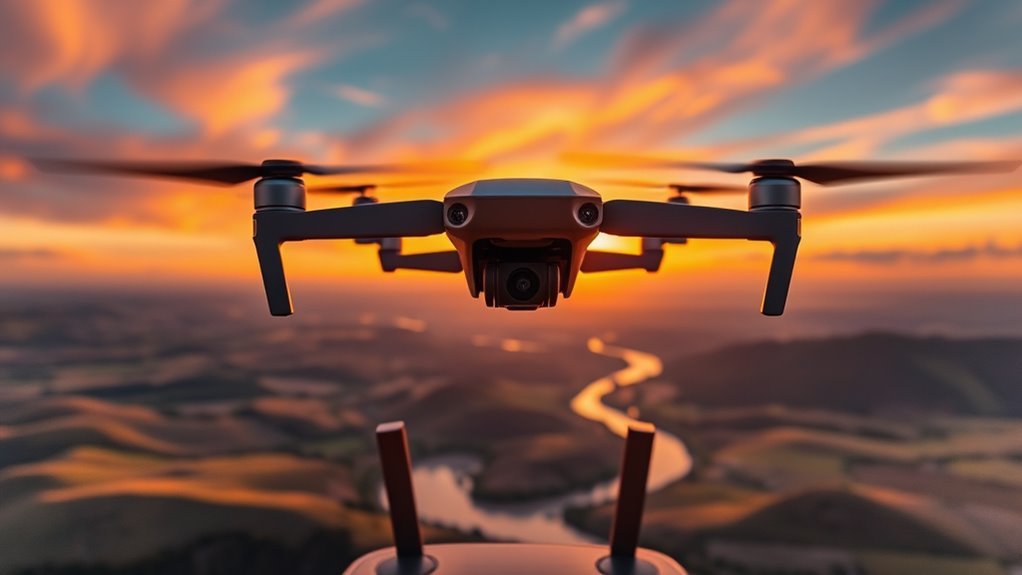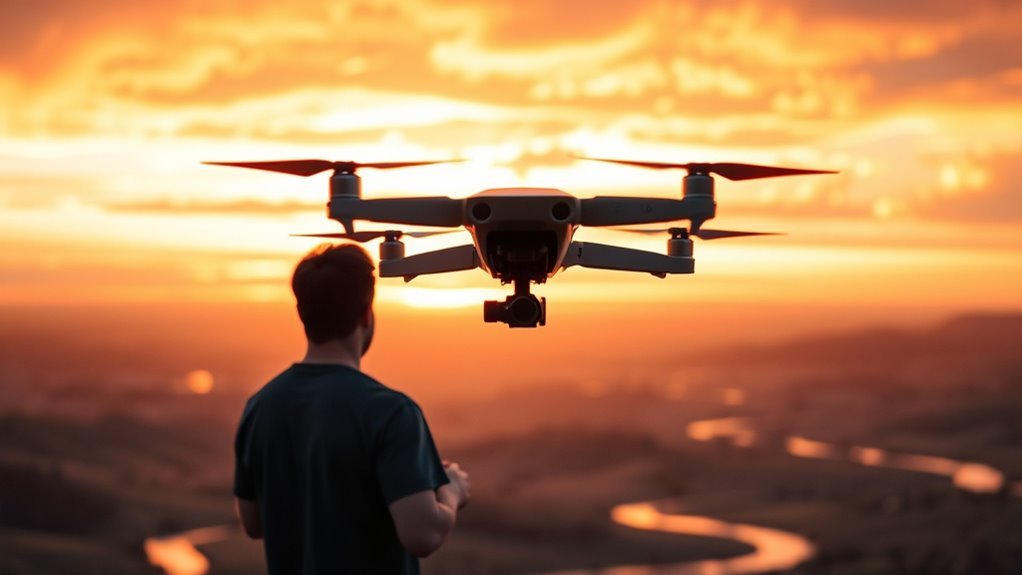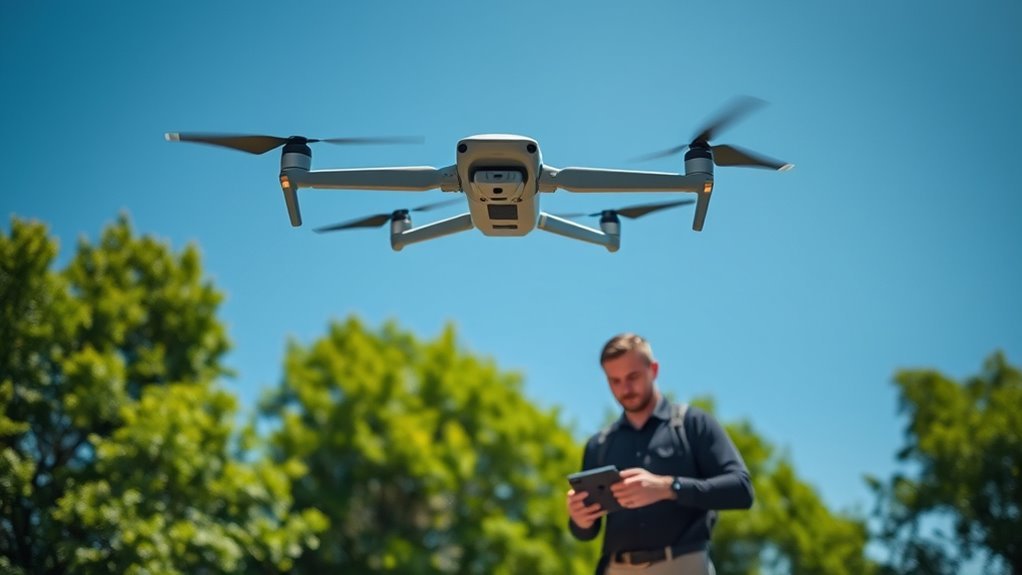Headless mode is a feature that simplifies drone flying by aligning the controls with your perspective, letting you navigate without worrying about the drone’s orientation. It works by redefining the drone’s front based on where you’re positioned. This mode is especially beneficial for beginners and in low visibility conditions, allowing for easier control. It’s crucial to confirm correct settings and check for common issues. Keep exploring to uncover detailed tips and best practices for maximizing your flying experience.
What Is Headless Mode?

Headless mode is a flight feature that simplifies drone navigation. It fundamentally alters how you interact with your drone, allowing you to control it without worrying about its orientation. In traditional flight dynamics, the front of the drone dictates its movement. However, with headless mode, regardless of the drone’s direction, pushing forward on the control stick moves it away from you. This innovation in drone technology empowers you to focus on your creativity and exploration, rather than on complex controls. It’s especially beneficial for beginners or those seeking an intuitive flying experience. By enabling effortless maneuverability, headless mode transforms how you engage with the skies, granting you the freedom to explore without the constraints of conventional flight mechanics.
How Does Headless Mode Work?

In headless mode, the drone’s control system redefines its orientation based on the pilot’s perspective. This means that regardless of the drone’s actual direction, the forward movement corresponds to the pilot’s front. When you push the control stick forward, the drone moves away from you, even if it’s facing sideways. This functionality relies on advanced drone technology, which utilizes sensors to maintain flight stability and determine the drone’s position relative to you. By eliminating the need to constantly adjust for the drone’s orientation, headless mode simplifies navigation, especially for beginners. You can focus more on capturing stunning aerial views without getting disoriented, making your flight experience more intuitive and freeing.
Benefits of Using Headless Mode

Using headless mode simplifies control navigation by aligning the drone’s movements with your perspective, regardless of its orientation. This feature enhances the learning experience for new users, allowing them to focus on flying rather than adjusting to the drone’s direction. It’s particularly ideal for beginners who may feel overwhelmed by traditional controls, making flight more intuitive and enjoyable.
Simplified Control Navigation
When you’re maneuvering a drone, the complexity of orientation can often lead to confusion, especially for beginners. Headless mode offers you simplified controls and intuitive navigation, making your flying experience much more enjoyable. Here are some key benefits:
- Consistent Orientation: The drone moves relative to your position, not its front.
- Easier Direction Control: You don’t have to worry about which way the drone is facing.
- Enhanced Focus on Flight: Spend less time thinking about orientation and more on capturing stunning footage.
- Quick Learning Curve: Beginners can grasp the basics of flying without the added stress of directional challenges.
Using headless mode empowers you to fly freely, letting you concentrate on exploration and creativity without unnecessary complications.
Enhanced Learning Experience
While mastering drone operation can be intimidating for beginners, headless mode greatly enhances the learning experience by simplifying the flight dynamics. This mode allows you to focus on control rather than orientation, making it easier to navigate and practice.
| Benefits | Description |
|---|---|
| Simplified Navigation | Eliminates confusion about drone direction. |
| Greater Confidence | Builds trust in your flying skills. |
| Interactive Tutorials | Offers hands-on experience in a controlled way. |
| Immersive Simulations | Engages you in real-time learning scenarios. |
With headless mode, you’ll find yourself more engaged in interactive tutorials and immersive simulations, allowing for a smoother shift from novice to skilled pilot. Embrace the freedom to explore and learn without the added pressure of orientation challenges.
Ideal for Beginners
Headless mode is particularly advantageous for beginners who are still familiarizing themselves with drone controls. By engaging this feature, you can enhance your flying experience and improve drone safety. Here are some key benefits:
- Simplified Navigation: You don’t need to worry about the drone’s orientation.
- Reduced Confusion: Forward and backward controls remain consistent, making it easier to manage.
- Less Risk of Crashes: With simplified controls, you’re less likely to lose control and crash.
- Confidence Boost: As you gain proficiency, you’ll feel more comfortable flying in various environments.
Utilizing headless mode allows you to focus on mastering basic flying skills without the overwhelming complexity of direction, making it an ideal choice for new drone enthusiasts.
When to Use Headless Mode
Headless mode is particularly useful for beginner pilots who may struggle with orientation while flying. It simplifies control by allowing you to direct the drone based on your position, rather than its front-facing direction. Additionally, in complex environments with obstacles, headless mode can help you navigate more easily without losing track of your drone’s orientation.
Beginner-Friendly Flying
Have you ever felt disoriented while trying to control a drone? That’s where headless mode comes in, especially for beginners. It simplifies flying, allowing you to focus on the experience rather than orientation. Here are some beginner tips on when to use headless mode for enhanced flying safety:
- First-time flying: It helps you gain confidence without worrying about drone direction.
- Open spaces: Use it when you’re practicing in vast, unobstructed areas.
- Low visibility: Activate it in conditions where visual orientation is challenging.
- Learning maneuvers: It’s ideal for mastering basic movements without added complexity.
Utilizing headless mode can considerably enhance your flying experience, giving you the freedom to explore the skies with ease.
Navigating Complex Environments
For those venturing into more intricate flying environments, headless mode can be a valuable tool. It simplifies navigation by aligning your drone’s controls to your perspective, enhancing spatial awareness. In complex settings, where obstacles abound, this mode aids in precise maneuverability, allowing you to focus on avoiding obstacles rather than recalibrating your orientation.
Here’s a quick reference table for when to use headless mode:
| Situation | When to Use Headless Mode |
|---|---|
| Flying in tight spaces | Yes |
| Avoiding obstacles | Yes |
| Outdoor flying | No |
| Long-range flights | No |
| Rapid direction changes | Yes |
Utilizing headless mode effectively can free you to explore challenging environments with greater confidence.
How to Activate Headless Mode
To activate headless mode on your drone, you’ll typically need to follow a straightforward sequence of steps. This feature offers headless benefits, making it easier for beginners to control their drone without worrying about orientation. Here are some beginner tips to get you started:
- Power On: Turn on your drone and remote controller.
- Pair Devices: Verify your drone is properly paired with the controller.
- Activate Mode: Locate the headless mode button, often labeled as “Headless” or “Mode.”
- Confirm Activation: Check for LED indicators or sounds confirming headless mode is active.
How to Deactivate Headless Mode
To deactivate headless mode on your drone, you’ll first need to access the drone’s settings through the controller or app. Once there, locate the headless mode option in the menu. Confirm the deactivation process to return to standard flight controls.
Accessing Drone Settings
While managing your drone’s settings, deactivating headless mode is a straightforward process that can greatly enhance your control during flight. To navigate through your drone configuration for this adjustment, follow these steps in your settings overview:
- Power on your drone and remote controller.
- Access the settings menu on your controller’s display.
- Locate the flight mode options.
- Toggle the headless mode setting to deactivate.
Locate Headless Mode Option
How can you quickly find the headless mode option on your drone? First, consult your drone’s user manual, as the location can vary by model. Typically, it’s found in the settings menu or labeled on the remote control. Look for indicators like “Headless Mode” or an icon representing orientation.
While headless mode offers advantages such as simplified navigation and ease of control, it also presents challenges, including potential disorientation if you lose track of your drone’s position. Once you locate the option, you’ll be empowered to toggle headless mode on or off, allowing you to harness its benefits or revert to standard control for more advanced maneuvers. Make sure to practice either mode in a safe area.
Confirm Deactivation Process
Once you’ve decided to deactivate headless mode, the process is typically straightforward. You’ll find various deactivation methods depending on your drone’s user interface. Here’s how to do it:
- Access Settings: Navigate to the flight mode settings on your controller or app.
- Select Headless Mode: Locate the headless mode option, usually highlighted for easy identification.
- Deactivate: Toggle the headless mode off. You may see a confirmation message.
- Test Flight: Conduct a brief test flight to verify the drone responds to directional controls as expected.
Common Misconceptions About Headless Mode
Many drone enthusiasts mistakenly believe that headless mode eliminates the need for orientation awareness, leading to a false sense of security when flying. This misunderstanding can cause issues, especially in complex environments. Here are some common myths about headless mode:
| Myth | Reality | Impact |
|---|---|---|
| It’s foolproof for beginners. | It still requires practice and skill. | Overconfidence may lead to crashes. |
| It works in all flying conditions. | Limitations exist in GPS and signal strength. | Loss of control in challenging areas. |
| Orientation is irrelevant. | You must still understand your drone’s position. | Mistakes can occur if not aware. |
Additionally, understanding signal reliability is crucial, as it influences how well a drone can operate in various environments. It’s essential to remain aware of drone laws and regulations to ensure safe flying practices.
Tips for Flying in Headless Mode
While flying in headless mode can simplify control for beginners, mastering a few key tips can enhance your experience and safety. Here are some essential tips for overcoming flying challenges:
- Know Your Orientation: Always verify which direction the drone’s front is facing before takeoff.
- Practice in Open Areas: Start in spacious environments to minimize obstacles and distractions.
- Maintain Line of Sight: Keep the drone within your visual range to better manage its movements.
- Use Low Altitude: Fly at lower altitudes initially to boost your confidence and control.
Implementing these tips for beginners will allow you to enjoy the freedom of flight while ensuring a safer and more enjoyable experience in headless mode.
Troubleshooting Headless Mode Issues
Even with the right tips for flying in headless mode, you might encounter issues that can disrupt your experience. Headless mode troubleshooting often revolves around a few common issues. First, confirm your drone’s orientation is correctly set before takeoff; if it’s misaligned, the drone may not respond as expected. Second, check for signal interference; obstacles or electronic devices can affect communication. If the drone drifts unexpectedly, recalibrate the gyroscope according to the manufacturer’s instructions. Additionally, verify that your battery is adequately charged, as low power can impact performance. Finally, if the remote isn’t syncing, try re-pairing it with the drone. Addressing these common issues will help you regain control and enjoy the freedom that headless mode offers. Additionally, understanding line of sight requirements is essential for maintaining safe drone operation and preventing unexpected issues during flight.
Comparing Headless Mode to Traditional Control Methods
- Simplified Control: You can fly without worrying about which way the drone is facing.
- Enhanced Maneuverability: It allows for easier navigation in tight spaces.
- Reduced Learning Curve: Beginners can grasp flying techniques more quickly.
- Consistent Responses: The drone reacts predictably to your inputs, regardless of its orientation.
Frequently Asked Questions
Can I Use Headless Mode With Any Drone Model?
Not every drone’s built the same, right? Drone compatibility varies. While many models support headless mode, you’ll need to check the specifications. Different flight modes can enhance your experience, so always verify your drone’s features.
Does Headless Mode Affect Flight Stability?
Headless mode can impact flight dynamics, as it alters control response based on orientation. While it simplifies navigation, it might reduce stability, especially in windy conditions or complex maneuvers, limiting your freedom in flight.
What Happens if I Lose Connection While in Headless Mode?
If you lose connection while in headless mode, your drone might drift away like a lost ship at sea. Connection recovery can be tricky, often resulting in uncontrolled flight due to signal loss and lack of direction.
Is Headless Mode Suitable for Beginners Only?
Headless mode isn’t just for beginners; its advantages, like simplified controls and enhanced maneuverability, can benefit any pilot. However, beginner tips suggest starting with it to build confidence before tackling advanced flying techniques.
Can Headless Mode Be Used for Aerial Photography?
While headless mode offers simplicity, it may compromise drone stability concerns during aerial photography techniques. For capturing stunning shots, mastering traditional controls might provide the freedom and precision you’ll need to achieve peak results.

